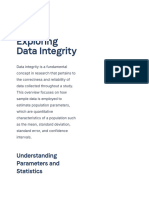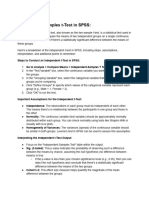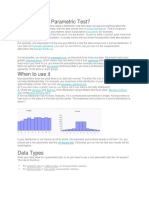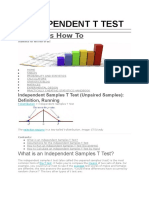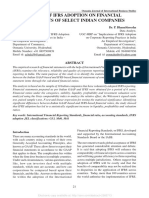Community Project: Checking Normality For Parametric Tests in SPSS
Uploaded by
fadzilCommunity Project: Checking Normality For Parametric Tests in SPSS
Uploaded by
fadzilcommunity project
encouraging academics to share statistics support resources
All stcp resources are released under a Creative Commons licence
stcp-marshallsamuels-normalityS
The following resources are associated:
Statistical Hypothesis Testing worksheet and Normality Checking example solutions worksheet
Workshop 7: SPSS and Workshop 8: Parametric Testing, SPSS dataset NormS
Checking normality for parametric tests in SPSS
One of the assumptions for most parametric tests to be reliable is that the data is approximately
normally distributed. The normal distribution peaks in the middle and is symmetrical about the
mean. Data does not need to be perfectly normally distributed for the tests to be reliable.
Checking normality in SPSS
Data: The SPSS dataset ‘NormS’ contains the variables used in this sheet including the exercises.
To check if a variable is normally distributed use Analyze Descriptive Statistics Explore:
Select the Plots…
button and the
‘Normality plots
with tests’ and the
‘Histogram’ options
When carrying out tests comparing groups, e.g. t-tests, normality checks should be carried
out separately for each group: put the appropriate grouping variable in the Factor List
Graphical methods for assessing if data is normally distributed
Plotting a histogram of the variable of interest will give an indication of the shape of the
distribution. A normal approximation curve can also be added by editing the graph. Below are
examples of histograms of approximately normally distributed data and heavily skewed data with
equal sample sizes.
© Peter Samuels and Ellen Marshall Reviewer: Jamal Lahmar
Birmingham City University and Sheffield Hallam University University of Sheffield
Checking normality in SPSS
Histogram of approximately normally
Histogram of skewed data
distributed data
Note: Normal curves can be added to histograms by double-clicking on them and using the
button in the Chart Editor window.
It is very unlikely that a histogram of sample data will produce a perfectly smooth normal curve like
the one displayed over the histogram, especially if the sample size is small. As long as the data is
approximately normally distributed, with a peak in the middle and fairly symmetrical, the
assumption of normality has been met.
The normal Q-Q plot is an alternative graphical method of assessing normality to the histogram
and is easier to use when there are small sample sizes. The scatter should lie as close to the line
as possible with no obvious pattern coming away from the line for the data to be considered
normally distributed. Below are the same examples of normally distributed and skewed data.
Q-Q plot of approximately normally
Q-Q plot of skewed data
distributed data
Note: Alternative methods of measuring non-normality include comparing skewness and kurtosis
values with their standard errors which are provided in the Explore output – see the workshops on
SPSS and parametric testing.
Tests for assessing if data is normally distributed
There are also specific methods for testing normality but these should be used in conjunction with
either a histogram or a Q-Q plot. The Kolmogorov-Smirnov test and the Shapiro-Wilk’s W test
determine whether the underlying distribution is normal. Both tests are sensitive to outliers and are
influenced by sample size:
• For smaller samples, non-normality is less likely to be detected but the Shapiro-Wilk test
should be preferred as it is generally more sensitive
statstutor community project www.statstutor.ac.uk
Checking normality in SPSS
• For larger samples (i.e. more than one hundred), the normality tests are overly conservative
and the assumption of normality might be rejected too easily (see robust exceptions below).
Any assessment should also include an evaluation of the normality of histograms or Q-Q plots
as these are more appropriate for assessing normality in larger samples.
Hypothesis test for a test of normality
Null hypothesis: The data is normally distributed
For both of these examples, the sample size is 35 so the Shapiro-Wilk test should be used. For
the skewed data, p = 0.002 suggesting strong evidence of non-normality. For the approximately
normally distributed data, p = 0.582, so the null hypothesis is retained at the 0.05 level of
significance. Therefore, normality can be assumed for this data set and, provided any other test
assumptions are satisfied, an appropriate parametric test can be used.
What if the data is not normally distributed?
If the checks suggest that the data is not normally distributed, there are three options:
• Transform the dependent variable (repeating the normality checks on the transformed data):
Common transformations include taking the log or square root of the dependent variable.
• Use a non-parametric test: Non-parametric tests are often called distribution free tests and
can be used instead of their parametric equivalent.
• Use a parametric test under robust exceptions: These are conditions when the parametric
test can still be used for data which is not normally distributed and are specific to individual
parametric tests – see the appropriate test worksheet.
Key non-parametric tests
Parametric test What to check for normality Non-parametric test
Independent t-test Dependent variable by group Mann-Whitney test
Paired t-test Paired differences Wilcoxon signed rank test
One-way ANOVA Residuals/ dependent variable by Kruskal-Wallis test
group
Repeated measures ANOVA Residuals at each time point Friedman test
Pearson’s correlation Both variables should be normally Spearman’s correlation
coefficient distributed coefficient
Simple linear regression Residuals N/A
Note: The residuals are the differences between the observed and expected values. They are
usually available in the ‘Save’ options when carrying out a test. However, for ANOVA, residuals
can only be obtained through the Analyze General Linear Model Univariate menu.
Although non-parametric tests require fewer assumptions and can be used on a wider range of
data types, parametric tests are preferred because they are more sensitive at detecting differences
between samples or an effect of the independent variable on the dependent variable. This means
statstutor community project www.statstutor.ac.uk
Checking normality in SPSS
that to detect any given effect at a specified significance level, a larger sample size is required for
the non-parametric test than the equivalent parametric test when the data is normally distributed.
However, some statisticians argue that non-parametric methods are more appropriate with small
sample sizes.
Where to find non-parametric tests in SPSS
Examples (see solutions below)
Example 1: Class data has been collected on BMI (Ex1_BMI). Use graphical methods as well as
tests to check normality of the variable Ex1_BMI.
Example 2
A study was carried out to compare whether exercise has an effect on the blood pressure
(measure in mm Hg). The blood pressure was measured on 15 people before and after exercising.
The results are contained in Ex2_before and Ex2_after:
Subject 1 2 3 4 5 6 7 8 9 10
Before 85.1 108.4 79 109.1 97.3 96 102.1 91.2 89.2 100
After 86 70 78.9 69.7 59.4 55 65.6 50.2 60.5 82
Carry out the relevant normality checks and determine which test is appropriate.
Solutions
Ex 1: The p-value for the Shapiro-Wilk test is 0.001 suggesting that the data is not normally
distributed. However, the histogram suggests that the data is approximately normal with one
outlier. With such a high BMI, this is likely to be a data entry error and therefore removed.
Ex 2: This is paired data and therefore the paired differences should be checked for normality.
Use Transform Compute Variable and calculate the difference between before and after. The
Shapiro-Wilk test has a p-value of 0.005 and the histogram is negatively skewed so a paired t-
test is not appropriate. A Wilcoxon signed rank test should be used instead. For small sample
sizes, it can be difficult to assess non-normality so non-parametric tests are recommended.
statstutor community project www.statstutor.ac.uk
You might also like
- Statistics Translated: A Step-by-Step Guide to Analyzing and Interpreting Data 2nd Edition Steven R. Terrell 2024 Scribd Download100% (4)Statistics Translated: A Step-by-Step Guide to Analyzing and Interpreting Data 2nd Edition Steven R. Terrell 2024 Scribd Download50 pages
- Effect of Gender On Short Term Memory FinishedNo ratings yetEffect of Gender On Short Term Memory Finished27 pages
- Module 8 Inferential Statistics NonParametric TestNo ratings yetModule 8 Inferential Statistics NonParametric Test112 pages
- 09 Introduction To Nonparametric MethodsNo ratings yet09 Introduction To Nonparametric Methods32 pages
- Intuitive Biostatistics: Choosing A Statistical Test: Back Completely Revised Second EditionNo ratings yetIntuitive Biostatistics: Choosing A Statistical Test: Back Completely Revised Second Edition6 pages
- Intuitive Biostatistics: Choosing A Statistical TestNo ratings yetIntuitive Biostatistics: Choosing A Statistical Test5 pages
- Chapter 13 - Tests For The Assumption That A Variable Is Normally Distributed Final - EditedNo ratings yetChapter 13 - Tests For The Assumption That A Variable Is Normally Distributed Final - Edited4 pages
- Module 004 - Parametric and Non-ParametricNo ratings yetModule 004 - Parametric and Non-Parametric12 pages
- Chapter 2 - Advance Computer Skills (SPSS)No ratings yetChapter 2 - Advance Computer Skills (SPSS)58 pages
- Non Parametric Test: Business Research MethodsNo ratings yetNon Parametric Test: Business Research Methods26 pages
- Statistical Analysis Using SPSS and R - Chapter 4 PDFNo ratings yetStatistical Analysis Using SPSS and R - Chapter 4 PDF106 pages
- LM-Webinar On Multivariate Techniques For Research - Intro and MRANo ratings yetLM-Webinar On Multivariate Techniques For Research - Intro and MRA24 pages
- Parametric Vs Non Parametric Statistical TestsNo ratings yetParametric Vs Non Parametric Statistical Tests3 pages
- Distribution Free Methods, Which Do Not Rely On Assumptions That TheNo ratings yetDistribution Free Methods, Which Do Not Rely On Assumptions That The4 pages
- Why Is It Important To Consider Sample Size?No ratings yetWhy Is It Important To Consider Sample Size?98 pages
- All Statistical Tests and Their Applications Updated Latest Latest Latest LatestNo ratings yetAll Statistical Tests and Their Applications Updated Latest Latest Latest Latest14 pages
- Dr. SK Ahammad Basha Non Parametric Tests 1No ratings yetDr. SK Ahammad Basha Non Parametric Tests 137 pages
- One-Sample Z-Tests: Other PASS Procedures For Testing One Mean or MedianNo ratings yetOne-Sample Z-Tests: Other PASS Procedures For Testing One Mean or Median12 pages
- Tips and Tricks For Analyzing Non-Normal DataNo ratings yetTips and Tricks For Analyzing Non-Normal Data3 pages
- National Council of Teachers of Mathematics Is Collaborating With JSTOR To Digitize, Preserve and Extend Access To The Mathematics TeacherNo ratings yetNational Council of Teachers of Mathematics Is Collaborating With JSTOR To Digitize, Preserve and Extend Access To The Mathematics Teacher6 pages
- Data Envelopment Analysis History Models and InterNo ratings yetData Envelopment Analysis History Models and Inter40 pages
- Code-Switching Attitudes and Practices and The Student'S Academic Achievement in English Research MethodologyNo ratings yetCode-Switching Attitudes and Practices and The Student'S Academic Achievement in English Research Methodology10 pages
- Project Report: A Study On Recruitment and Selection Process at Max Fashions, ChennaiNo ratings yetProject Report: A Study On Recruitment and Selection Process at Max Fashions, Chennai74 pages
- An Investigation Into Mathematics Perfor PDFNo ratings yetAn Investigation Into Mathematics Perfor PDF10 pages
- Hypothesis Testing With One Sample: Larson & Farber, Elementary Statistics: Picturing The World, 3e 3No ratings yetHypothesis Testing With One Sample: Larson & Farber, Elementary Statistics: Picturing The World, 3e 323 pages
- Basic Stats:: A Supplement To Multivariate Data AnalysisNo ratings yetBasic Stats:: A Supplement To Multivariate Data Analysis55 pages
- PSY112 - 5th Exam - Problem Solving QuestionnaireNo ratings yetPSY112 - 5th Exam - Problem Solving Questionnaire2 pages
- Ba 5211 - Data Analysis and Business ModelingNo ratings yetBa 5211 - Data Analysis and Business Modeling88 pages
- Uji Normalitas: One-Sample Kolmogorov-Smirnov TestNo ratings yetUji Normalitas: One-Sample Kolmogorov-Smirnov Test9 pages
- Life After Imprisonment Autosaved Chapt3 FNo ratings yetLife After Imprisonment Autosaved Chapt3 F24 pages
- 2 Assignment For Data Analysis For Decision Making: Dipanwita GhoshNo ratings yet2 Assignment For Data Analysis For Decision Making: Dipanwita Ghosh13 pages
- Impact of Ifrs Adoption On Financial StaNo ratings yetImpact of Ifrs Adoption On Financial Sta13 pages
- PDF Medical Statistics from Scratch David Bowers download100% (2)PDF Medical Statistics from Scratch David Bowers download40 pages
- Statistics Translated: A Step-by-Step Guide to Analyzing and Interpreting Data 2nd Edition Steven R. Terrell 2024 Scribd DownloadStatistics Translated: A Step-by-Step Guide to Analyzing and Interpreting Data 2nd Edition Steven R. Terrell 2024 Scribd Download
- Module 8 Inferential Statistics NonParametric TestModule 8 Inferential Statistics NonParametric Test
- Intuitive Biostatistics: Choosing A Statistical Test: Back Completely Revised Second EditionIntuitive Biostatistics: Choosing A Statistical Test: Back Completely Revised Second Edition
- Intuitive Biostatistics: Choosing A Statistical TestIntuitive Biostatistics: Choosing A Statistical Test
- Chapter 13 - Tests For The Assumption That A Variable Is Normally Distributed Final - EditedChapter 13 - Tests For The Assumption That A Variable Is Normally Distributed Final - Edited
- Statistical Analysis Using SPSS and R - Chapter 4 PDFStatistical Analysis Using SPSS and R - Chapter 4 PDF
- LM-Webinar On Multivariate Techniques For Research - Intro and MRALM-Webinar On Multivariate Techniques For Research - Intro and MRA
- Distribution Free Methods, Which Do Not Rely On Assumptions That TheDistribution Free Methods, Which Do Not Rely On Assumptions That The
- All Statistical Tests and Their Applications Updated Latest Latest Latest LatestAll Statistical Tests and Their Applications Updated Latest Latest Latest Latest
- One-Sample Z-Tests: Other PASS Procedures For Testing One Mean or MedianOne-Sample Z-Tests: Other PASS Procedures For Testing One Mean or Median
- National Council of Teachers of Mathematics Is Collaborating With JSTOR To Digitize, Preserve and Extend Access To The Mathematics TeacherNational Council of Teachers of Mathematics Is Collaborating With JSTOR To Digitize, Preserve and Extend Access To The Mathematics Teacher
- Data Envelopment Analysis History Models and InterData Envelopment Analysis History Models and Inter
- Code-Switching Attitudes and Practices and The Student'S Academic Achievement in English Research MethodologyCode-Switching Attitudes and Practices and The Student'S Academic Achievement in English Research Methodology
- Project Report: A Study On Recruitment and Selection Process at Max Fashions, ChennaiProject Report: A Study On Recruitment and Selection Process at Max Fashions, Chennai
- Hypothesis Testing With One Sample: Larson & Farber, Elementary Statistics: Picturing The World, 3e 3Hypothesis Testing With One Sample: Larson & Farber, Elementary Statistics: Picturing The World, 3e 3
- Basic Stats:: A Supplement To Multivariate Data AnalysisBasic Stats:: A Supplement To Multivariate Data Analysis
- Uji Normalitas: One-Sample Kolmogorov-Smirnov TestUji Normalitas: One-Sample Kolmogorov-Smirnov Test
- 2 Assignment For Data Analysis For Decision Making: Dipanwita Ghosh2 Assignment For Data Analysis For Decision Making: Dipanwita Ghosh
- PDF Medical Statistics from Scratch David Bowers downloadPDF Medical Statistics from Scratch David Bowers download









